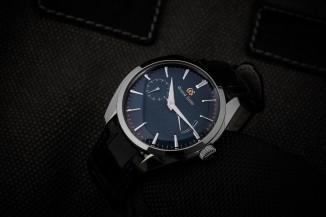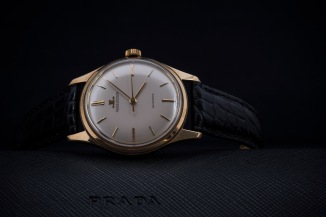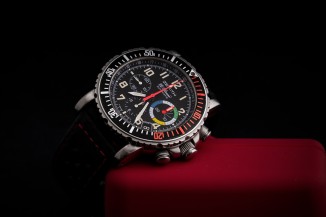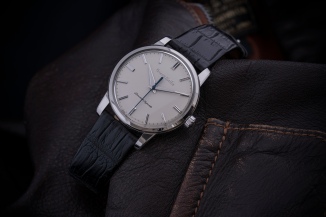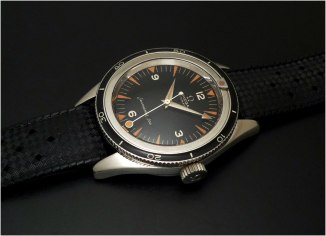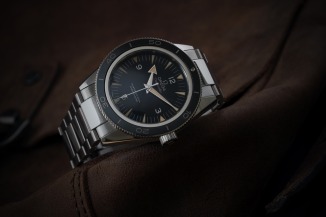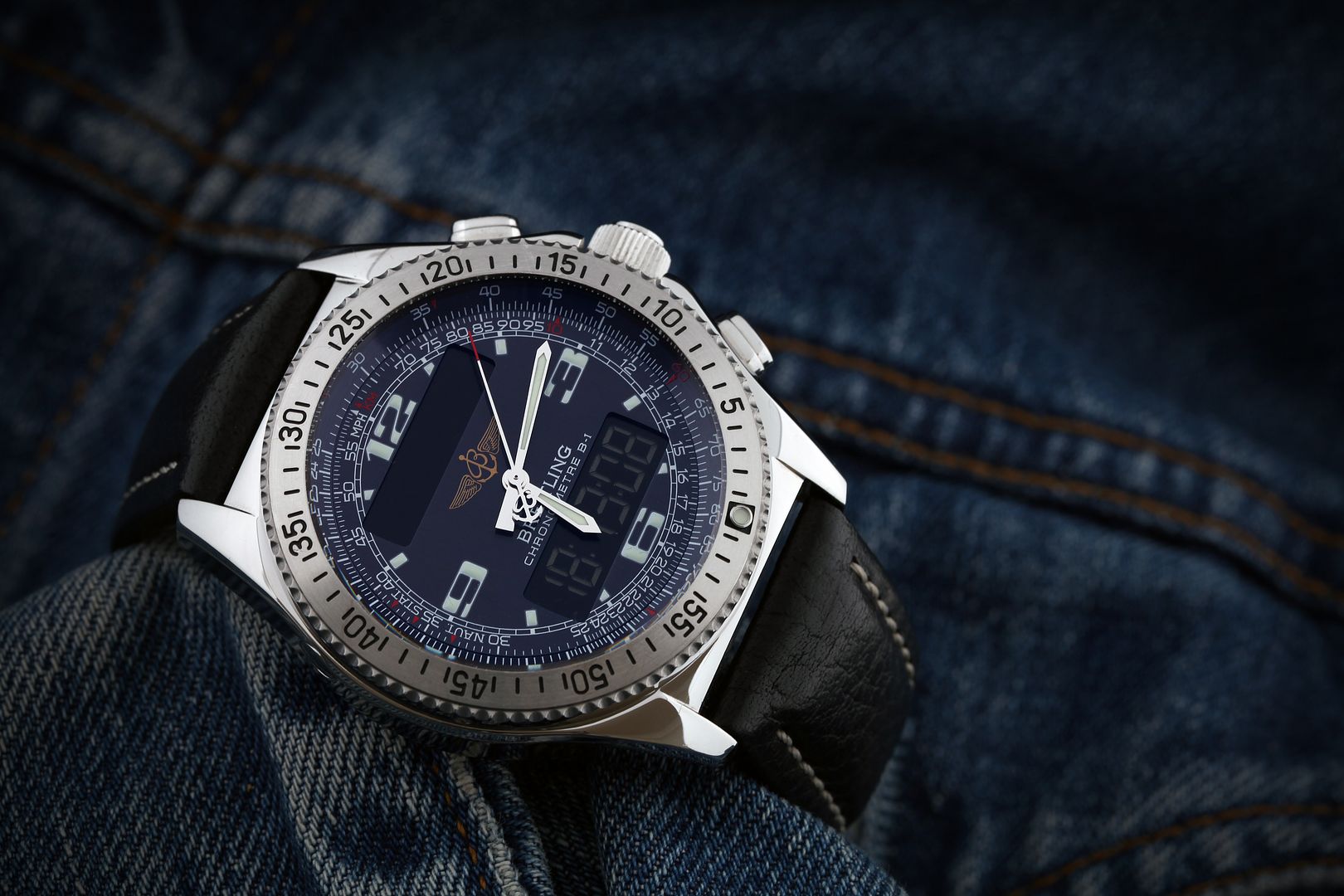It’s been a while since I last posted, and this piece once again is about changes to what seems to be an ever-growing collection (not through any planning or intent on my part, I hasten to add – I actually thought I might be able to get the numbers down a bit). That said, I’ve had some new arrivals over the past few months so I thought I’d write a quick update for those that might have an interest 🙂
Omega SM300 new build
I’ve admired these from afar for absolutely ages, as I love the originals and had a WTB for one for quite a while. There have been some lovely examples passing through SC but I’ve never quite managed to nab one, but finally this unworn example reared its head in Singapore and it seemed too good an opportunity to miss. It’s one of the sought-after Lewis Watch Company builds, and there’s a post on the Omega Forum that sets out the background very nicely. For those who don’t like to follow links, here’s the gist of it…
What I’ve done with these is a fair bit more thorough than what Watchco did with theirs a few years back.
The movements are still from donor watches (565 for date and 552 without date). However they have had no expense spared servicing performed which included as a minimum new centre wheels, cannon pinions, mainsprings of course, some have had new barrels, barrel bridges, balances. Essentially whatever they needed in terms of new parts as well as traditional techniques to reduce or eliminate the effects of 50 odd years of wear on someone’s wrist.
Add to that entirely synthetic lubrication and at least a month of testing and fine tuning. Each case back has been professionally engraved on the inside with the serial of the movement, the build date, my company initials and the sequence number (1 of 6).
They have all been tested waterproof to 100meters which is all the Witschi Proofmaster S will go to. – This is a professional grade machine and is extremely sensitive to case deformation under vacuum and pressure. They have also been wet tested. I then produced a certificate for each watch giving its particulars. It’s timing and waterproof test performance numbers are listed.
ALL parts are new stock except of course the movement. ALL parts used are Omega and the correct ones for this reference, right down to the case clamps and screws. ALL bezels align properly at 12, no dodgy factory seconds here.
I have added the latest deployant clasp and leather or rubber strap which are also Omega items. Perhaps controversially I don’t like the mesh bracelet ( apart from to look at ) as it’s hard to get a proper fit and is uncomfortable to wear. Likewise the 1171 / 633 is a $25 bracelet with a $400 price tag.
Wrapping it all up is a brand new wooden Omega box of the Planet Ocean / modern SM300 variety. Plus a 12 month warranty on my workmanship.
So… a great build, two OEM leather straps and a deployant, a bit of paperwork, some engraving, a lovely box set and lume like a torch. What’s not to love?

Breitling Navitimer 806
I find the general love of all things Breitling a bit mystifying, if I’m honest. Whilst I don’t doubt their quality for a moment, I really haven’t seen many that I like and most are simply far too blingy for an old fart/traditionalist like me. That said, there has always been one exception, and that’s the Navitimer. Within the iconic chronograph hierarchy I believe it holds a place very near the top, and I shudder when I think that in the past I’ve simultaneously owned an 806, and Ed White and a white gold Daytona… all of which have slipped through my fingers.
Anyway, the Navitimer has a genuinely interesting heritage and history. After the great success of Breitling’s first slide-rule watch (the Chronomat), the Navitimer was launched all the way back in 1952. Whilst the Chronomat was focussed on the engineer and businessman market, the Navitimer was designed specifically for pilots; so much so that the “Aircraft Owners and Pilot Association” (AOPA) immediately decided to make it their official watch. This new Navitimer combined three essential tools for navigation – a watch, a chronograph and a slide-rule. It was, effectively, a navigation timer, hence the name it was given.
It was designed with the Venus 178 movement (although some later models contained a Valjoux), a well-respected column wheel chronograph, and the first to be produced were fitted with a black Arabic dial and the famous AOPA logo. In fact, on the very first models “Breitling” was only seen on the case back. Shortly afterwards, the Breitling name was added over the AOPA logo, sometimes topped with the “B”. The reference of this watch was 806, and remained so until the introduction of a completely new generation in the 1970’s.
Over the following years, there were a number of dial variations, each termed a “Generation” (numbered 1-7 or so up to the 70’s, at least); there are some reasonably good sources of information out there for anyone who may be interested, but it takes a bit of legwork and it can be a little confusing as not all historic accounts are completely consistent.
Anyway, this acquisition is lovely – a 2nd Generation 806 that dates to 1966. It really is in good all-original condition, with a white on black dial and incorporating the earlier/smaller subdials that I think are by far the nicer.
Aside from the fact that the case is unpolished but in great original shape, the patina on dial and hands is even and dark, and the subdials are gorgeous (it was also very recently serviced, but there was no attempt to clean the dial – there are obvious signs of discolouration, but on the plus side it means that it’s in untouched condition). Note the absence of red highlights too – seen on later/current models but unsubtle in comparison.
Just a little (more specific) information on the 2nd Generation variant, taken from the Net… in approximately 1960 – after the watch had already become a huge success – the Navitimer’s design was modified and thereafter became known as “2nd Generation”. The three subdials changed from black to white, the hands were remodelled and the Breitling name appeared in printing on the dial. During the 1960’s the slide-rule bezel was also remodelled twice. Moreover, the AOPA wing was removed from the dial and the official Breitling Navitimer logo became two aircrafts flying in close formation. At the same time, however, Breitling continued to supply AOPA with Navitimers sporting the AOPA logo on the dial.
So… here you go!
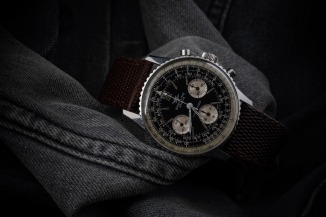
Omega Speedmaster 60th Anniversary
Now, I’ll state at the outset that I love this trilogy of tribute watches released by Omega. I already have the Seamaster 60th (I’m actually wearing it as I type, and it’s one of my favourite watches), so I was delighted when an opportunity arose to add it’s sibling. I’m actually tempted to get the Railmaster too, but I’ll have to have a good think about that before taking the plunge yet again.
I won’t bother writing any kind of history of the Speedmaster, but will just say (as I’m sure most people know by now) that the proportions and design of the 60th Anniversary are an exact match of those of the first model launched in 1957, the reference CK2915-1.
The dial as also a faithful reproduction of its ancestor, as are the broad arrow hands (seen again, also, on the previously released Speedmaster ’57); the applied Omega logo has been reincarnated, and the Omega Speedmaster signature is in the original font.
Whilst the 60th is a very faithful tribute, the movement is of course the modern caliber 1861. The bracelet is identical in style to ye original, but is far more solid and sports a very sold clasp with micro-adjustment on the fly. The lume – yes, it’s been given an aged look like the other two watches in the “set”, and some people will no doubt find that a little marmite – is a lovely bright luminova, whereas the original would have been radium. Finally, the “Swiss Made” is now above the seconds, track while it used to be below.
For comparison purposes, then, here’s the original…

And here’s the 60th!
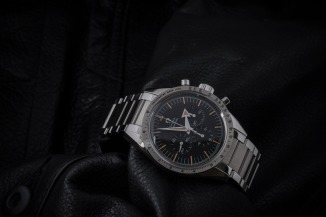
Actually, given that I mentioned its Seamaster sibling I may as well post a shot of that too, whilst I’m at it!

Blancpain Tribute to Fifty Fathoms Mil-Spec
Well, this is the last of the incomings, and to be honest it’s the one I’d been craving since I first heard of its release. In fact, I’ve paid more than one begging visit to the Bond Street boutique, even at one point trying to buy the prototype (only 500 were released globally, and the boutique were allocated just 2!).
To trace it back to it’s roots one has to travel back all the way to the early 1950’s – even before Rolex released the first iteration of the Submariner at 1954’s Basel Watch Fair. In 1952, the French “Nageuers de Combat” (combat swimmers) was formed by the French government as an elite team of tactical soldiers – effectively, they were France’s early equivalent of the Navy Seals. Led by Captain Bob Maloubier, the mission of this elite group of frogmen was undersea intelligence gathering and acts of sabotage, such as attacks in sea ports or destruction of ships, all accomplished by teams of divers often working at night.
Beyond their diving tanks, scuba regulators, masks, flippers and suits, Maloubier understood the importance of robust and reliable diving instruments, of which there were three: a compass, a depth metre and a diving watch. The watch was central to many of the key tasks confronting the divers. Of course the timing of the dive was an essential (it would not to do to over-stay the supply of oxygen). A second, and perhaps somewhat less obvious need was timing for navigation purposes. After running tests of the watches then available on the market, Maloubier concluded that none were up to the task. Thus, he decided to undertake the conception and design of a timing instrument that would target the needs of military combat diving.
Blancpain fulfilled these needs and provided the first model of this very specific divers watch in 1953, the “Fifty Fathoms”. The rest, I guess is history, but amongst the many models that have been produced since then the Mil-Spec (based closely on the original Mil-Spec that was produced in 1957 – so in fact another 60th anniversary release) is one of just two of the modern variants to be given a substantially more wearable case of “a mere” 40mm. I’ve previously owned both the standard auto and the Dark Knight, both of which were 45mm, and whilst I loved them both they were simply a little too big for me.
That half orange, half white circle you see prominently placed at six o’clock is an indicator for water ingress. If the dial is exposed to water – even a relatively small amount – the white part will begin to turn a reddish-orange to match the other side. However, with WR rated at 300m, one would sincerely hope that it’s not something that will ever be anything more than redundant functionality.
Inside, and unlike the larger FF’s, is the Blancpain calibre 1151 movement. In fact, it’s made by Piguet but has been used extensively by Blancpain, and also by Brequet, AP and VC. Only Blancpain is allowed by Piguet to have a 100 hour reserve, whilst other companies have to settle on a “measly” 70 hours. The movement doesn’t hack, either, which had me frantically consulting my Google-Fu to ensure that mine didn’t have a problem!
I’m absolutely delighted to have snagged this watch; I genuinely thought I’d missed the boat, so it was especially lovely to finally strap it to my wrist.






